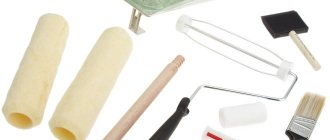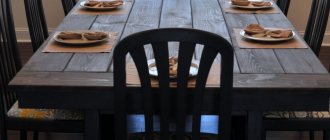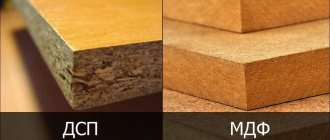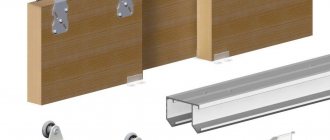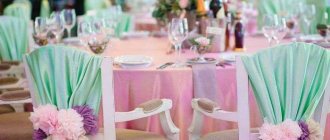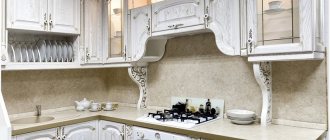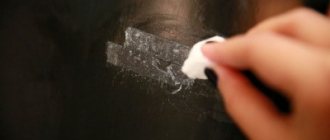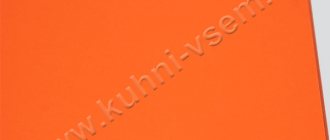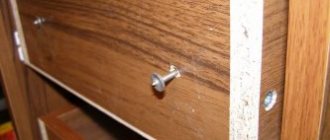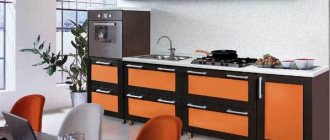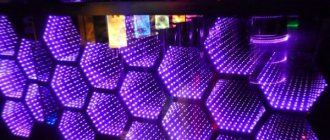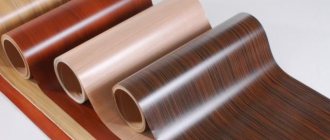The technology for manufacturing MDF came to our country from America thirty years after the start of industrial production of the material overseas. Slabs are not used for external work for several reasons.
- Expensive. There are many varieties of lumber that have higher performance at lower cost.
- Insufficient physical strength. In terms of resistance to dynamic and static loads, the slab does not meet the requirements of developers. It is easy to damage, but difficult to replace.
- Susceptibility to precipitation and temperature climatic conditions. There are options for moisture-resistant boards, but they are not suitable for cladding external wall surfaces.
MDF board
MDF board is used for the manufacture of furniture and cladding of internal wall surfaces. It is these cases that we will talk about. Painting of MDF facades will only be considered for enclosed spaces. Let us separately focus on painting the facades of MDF furniture.
MDF boards of different shades
Types of paints for MDF
Painted MDF
There is no need to list specific brands, and it is impossible to do so. We will only talk about the varieties and brief characteristics of paints, taking into account the method of their manufacture. The specific type must be selected taking into account the operating conditions of the MDF board, design preferences and financial capabilities. The range in price and quality is quite wide, there is plenty to choose from.
| Type of paints | Brief performance indicators |
| Water based | The most popular for painting large surfaces, they have satisfactory performance characteristics and are completely safe for residents. They can be white or colored, for interior and exterior work. |
| Acrylic-silicone | Combines the advantages of acrylic and silicone paints, an environmentally friendly product. Inhibits the proliferation of microflora and mosses, and has high levels of resistance to mechanical stress. |
| Silicone | They repel water and are not afraid of moisture and high temperatures. Surfaces are easily cleaned from dust and dirt. Due to their high elasticity, they can easily compensate for thermal expansion of MDF boards. |
| Polyvinyl acetate | Some of the cheapest, recommended for use indoors with minimal risk of damage. During use, you should strictly follow the manufacturers' recommendations, otherwise peeling will occur. |
| Oily | Traditional dyes, in addition to giving a beautiful appearance to surfaces, effectively protect them from moisture penetration. To increase adhesion, it is recommended to use primers. |
| Alkyd | They have a perfectly smooth surface and are made on the basis of alkyd enamels. Plastic, resistant to abrasion. Disadvantage: they fade quickly when exposed to direct sunlight. |
Before buying paint, calculate the surface area and purchase materials with a reserve. Consumption is indicated by the manufacturer. If it is recommended to coat the surface with a primer before painting, do not simplify the work. Insufficient adhesion of paint to the MDF board causes peeling. As a result, there is a need for expensive and time-consuming repairs.
What paints are suitable for MDF
Prices for different types of construction paints for wood
Construction paint for wood
Features and benefits of MDF
MDF has a medium density and is produced by pressing fine wood chips. The whole process takes place under high pressure and high temperature, and lignin, a natural substance, acts as a connecting link.
Most often, MDF boards are used for the manufacture of furniture fronts for bedside tables and wall cabinets, and the main advantages of this material include:
- Good indicator of resistance to moisture;
- Resistance to high temperatures;
- Strength;
- Convenience during operation;
- Low production cost and, as a result, low price on the market;
- Resistance to fungi.
All of these properties listed above make MDF boards simply an irreplaceable material for the manufacture of furniture doors and facades.
However, despite all its advantages, MDF, like any other material, eventually loses the brightness of its colors and is subject to natural wear and tear.
What to do in this case? There are two options for solving this problem - purchasing new furniture or restoring (painting) old facades. This will be discussed in our article.
Types of varnishes for MDF
The technology of coating surfaces with varnish is much more complicated than working with paints, but the effect justifies all the effort. When choosing a specific varnish, you need to take into account not only its properties and price, but also the location of application and operating conditions. The following types of varnishes can be used to coat MDF boards.
| Varnish type | Composition and brief characteristics |
| Alcohol | Made from ethyl alcohol and artificial resins. In terms of price, they belong to the low category; drying time, depending on the conditions and thickness of the layer, is 20–30 minutes. |
| Alkyd-urea | Two-component compositions are characterized by increased strength. They consist of urea and alkyd resins; a hardener must be added before use. They are characterized by increased strength and excellent shine. |
| Epoxy | Two-component, increased impact resistance, can have prolonged contact with water. Used to cover MDF tables. |
| Polyester | Resistant to aggressive chemical compounds, withstands elevated temperatures well. Multicomponent varnishes on polyester resin. |
| Nitrocellulose | The composition contains resins, plasticizers and solvents. They have high water resistance, are polished, and have average mechanical strength. |
| Acrylic-urethane | They are diluted with water, are safe for health, and have increased adhesion to surfaces. They can be exposed to high temperatures and humidity for a long time. |
| Polyurethane | They are produced in one-, two- and three-component versions. The complete hardening time is up to two weeks, they are characterized by increased wear resistance, and have a high adhesion coefficient with all lumber. |
| Acrylic | Odorless, non-toxic, diluted with water. Prolonged contact with food is allowed. In terms of performance characteristics they have average indicators. |
Sherwin Williams Wood Classics Polyurethane Varnish (Sherwin Williams)
This information will help when choosing a brand of varnish; consider as many individual factors as possible. Keep in mind that the appearance and service life of MDF facades largely depend on the quality of the composition.
Prices for various types of construction wood varnishes
Construction varnishes for wood
Application of primer
Application of primer FP 285 V (ICA)
The working soil solution is prepared in proportion to 100 parts by volume of FP 285 soil, C 285 or C271 - 30 parts by volume is added, the mixture is thoroughly stirred and 20-30 parts of solvent D1010 are added to it to obtain a working viscosity. At air temperatures > 24 C, use solvent D1015.
| Rice. 4. Preparation of working soil solution |
| Rice. 5. Adding hardener |
During operation, it is necessary to maintain a constant viscosity for 20-25 seconds (Ford mug no. 4), adding solvent if necessary.
When applying two layers, the viscosity for the first layer of primer is 50 sec.f., the second 25-35 sec.f., the second layer of primer can be applied after 1-4 hours without waiting for it to dry completely.
| Rice. 6. Blowing the facade before applying primer |
The survivability of the working solution with hardener is 4 hours. Apply the primer solution with a paint sprayer with a nozzle diameter of 1.8-2.0 mm and a pressure of 2.5-2.8 atm.
Soil consumption per layer is 150-200 g/sq.m. Dry from dust 15 minutes after applying primer, touchable after 30 minutes, sandable after at least 10 hours, completely dry 12 hours.
| Rice. 7. Application of primer |
If 4 hours have passed after applying the first layer of primer, the second layer of primer cannot be applied without intermediate sanding. Sanding can be done after 6-10 hours depending on the type of soil.
| Rice. 8. Drying MDF facades with primer applied on a shelf |
Intermediate sanding is done with sandpaper no. 280 grit, the second layer of primer is sanded with sandpaper no. 320, careful blowing of the parts is necessary.
| Rice. 9. Sanding MDF primer |
Drying of the insulating soil is carried out under natural conditions at a temperature of 18-25 C for 4-16 hours.
Such a long time is due to the fact that the curing of polyurethane coatings is not only a physical process, but also a chemical process that occurs over a certain time, during which a chemical reaction of the polyol with isocyanate occurs, with the formation of cross-linking and the formation of a three-dimensional structure.
The excess presence of isocyanate in the soil binds OH groups from the moisture of the slab and contributes to the formation of a more branched polymer structure. The primed surface must be smooth, without missing layers of soil.
Drips, stains, stripes, bubbles, scratches, peeling of the primer, and mechanical damage are not allowed. When sanding, sanded or unsanded areas, dents, scratches and deep scratches from the skins are not allowed.
Technology for painting furniture facades made of MDF
Quite complex work that requires care, skill and patience. They are made in several stages, each of which significantly affects the final quality. It is much faster and better to paint facades with a spray gun; if you don’t have one, use high-quality brushes with soft, durable bristles.
A classic and highly wear-resistant brush
The temperature in the room should be at least +20°C, if there are a lot of individual elements of the MDF facade, then think about the places for drying them: racks, supports, etc. In most cases, after painting the slabs, it is recommended to varnish them, it protects the surfaces from damage, hides minor flaws and significantly improves the design look. Varnishing is a complex process that requires special tools and equipment. We will tell you how MDF boards are varnished below, but for now we will focus on painting.
We have already told you what criteria to use to choose paint. For furniture facades, we can only add that the paint color should take into account the purpose of the furniture and the intensity of its use.
Step 1. Surface preparation. For furniture facades, in addition to cleaning from dust and degreasing the surfaces, it is imperative to sand them with sandpaper No. 150–180.
Sanding MDF before painting
Working manually is long and difficult, and achieving the desired quality is almost impossible. We recommend using a professional electric reciprocating surface grinder or cylindrical grinding unit.
Sanding MDF surface
The edges are sanded with special four-sided sponges. It is advisable to work in a respirator. When grinding, do not stop the tool in one place; it should always be in motion. One trace must overlap the next by at least a third of the width. There is no need to press the sandpaper too hard; if problem areas remain on the surface, it is better to go over the entire area again rather than making a depression in one place.
Practical advice. Any grinding is accompanied by a large amount of fine dust. Take all measures to ensure that it does not fall into adjacent rooms.
Step 2. Thoroughly clean surfaces from dust. Simple brushes are not enough; you definitely need a powerful vacuum cleaner or compressor. Check the condition of the parts; if there are sharp edges, remove them. The IMF does not have much strength; sharp corners will certainly crumble.
Step 3 . Prime the surfaces. Experienced craftsmen recommend using two types of primer, twice each. You can prime with one primer without stopping for drying; apply the first layer with horizontal movements of the spray gun, and the next immediately with vertical movements. Regulate the amount of primer; there should be no puddles on the surface. The first primer is used to prevent further absorption of materials, and the second to improve the adhesion coefficient between them. The second one is applied only after the first primer has completely dried. Primer consumption per square meter is 80–100 grams.
Primer for MDF
Practical advice. It is very difficult for novice craftsmen to determine consumption by eye. To gain this skill, we recommend taking a small piece of MDF and weighing it on an accurate scale. Coat with primer and immediately re-weigh. Next, the area of the sample is calculated and the increase in weight is determined. Using basic mathematical calculations, the primer consumption is determined. Not enough - add more. Now remember what the MDF surface looks like, covered with the optimal layer, and in the future prime with the same amount.
Applying primer
We strongly recommend working only with a pneumatic sprayer; using a brush will never achieve “factory” quality. A professional will always notice traces of lint. Moreover, the sun's rays fall on the furniture from different angles, and such lighting enhances all the shortcomings of facial coverings. Immediately prime the ends of the structures.
If you need to paint the back side of the slab, start work only after the front side has dried. The drying time is indicated by the manufacturer, but adjustments must be made taking into account the actual microclimate in the room.
It is more convenient to apply the primer with a sprayer
Step 4. Start sanding the soil, use special sponges. If you don’t have them, take dishwashing sponges; they have adhesive tape glued to the back side. This special material, used for fine grinding, not only levels out the coating, but also leaves micro-scratches on the surface that improve the adhesion of the next coating. Movements are arbitrary in different directions. Circular movements of the sponge are not recommended, only back and forth.
Scotch Brite sponge
Step 5: Blow or vacuum away any dust that has accumulated on the surface. Working with a spray gun is very convenient for another reason - you can shut off the paint supply and use it to clean surfaces from dust like a compressor.
Step 6 . Proceed with applying the second type of primer. It is predominantly white in color and improves the performance of the following coatings. It also needs to be primed twice followed by sanding. Blow the dust off the MDF again. The algorithm of actions is no different from the technology described above.
Applying a second coat of primer
Step 7. The second layer of primer must be carefully sanded with electric tools using fine sandpaper. Do not rush, large flaws will already become noticeable on the finished product. If you have no experience working with such machines, we strongly advise you to practice on unnecessary pieces of MDF. You will learn how hard to press the sanding paper to the surface, how quickly to move it, what thickness of MDF can be removed in one pass, etc.
Step 8: Prepare the paint. The preparation technology is indicated by the manufacturer on the packaging.
Painting MDF panels
Painting MDF facades
Follow all recommendations. We have already mentioned that to work with a spray gun, the consistency must be more liquid. Immediately paint twice in transverse directions. You should already have practical experience in determining the quality of the coating and the amount of paint. Paint consumption ranges from 60–180 g.
Polishing the painted surface
Painted polished MDF board
After the coating has dried, you can begin varnishing the surfaces. For furniture interiors this is a mandatory step. The varnish not only serves as additional and reliable protection, but also significantly improves the appearance of MDF products.
Painted MDF furniture facades
How to prepare a surface for painting?
While studying general information, many are interested in whether it is possible to paint MDF furniture without prior preparation. In principle, yes, but experts say that it is better not to neglect this point. You need to carefully prepare furniture for painting so that in the future there are no problems with it due to mechanical stress and temperature changes.
The surface preparation process includes the following steps:
- First, the products are processed with sandpaper to create a rough surface. If there are large scratches or cracks, they should be filled with wood putty, then sanded again to eliminate unevenness and differences. The main purpose of this treatment is to eliminate smoothness, which negatively affects adhesion.
- Then a primer is applied to the treated areas, which will provide them with additional adhesion and reduce the overall paint consumption. In addition, the primer allows you to create a barrier between the natural substances of the wood and the paint to prevent poor adhesion of the layers.
Coating MDF boards with varnish
We will describe how this is done below. But for quality, four main conditions must be met:
- do not use cheap varnishes;
- strictly adhere to technology;
- have the necessary tools and equipment;
- have experience in performing complex painting work.
You will gain experience in performing such work and the ability to use tools while priming and painting products; working with varnish will be much easier. You can determine the amount of varnish on the surface by eye, and the spray gun will “automatically” move in the right directions and at the optimal speed.
Step 1. According to the instructions, prepare the varnish, consumption is approximately 100-150 g per square meter.
Open and mix the varnish
Start coating with varnish from the ends of the MDF; due to this technology, it is possible to minimize the number of areas with uneven thickness. A little bit of varnish on the front surface does not pose a threat to the final quality.
The process of applying varnish using a brush
After the first layer has dried, sand it with the finest abrasive. Professionals recommend using abrasive fiber No. 1200 according to the international classification. It can be purchased in specialized stores.
Sandpaper No. 1200
Step 2. Remove dust from the surface. Examine surfaces from different angles in a well-lit room. Everything is fine - cover the surface with a second layer of varnish. By the way, it is recommended to coat some facades with varnish up to 0.5 mm thick, and for this you will have to increase the number of layers to five or more. At industrial enterprises, the technology is different, where the varnish is immediately poured onto the surface of the required thickness, then the sheets are fed on a conveyor into drying chambers. This technology cannot be used at home.
Step 3 . The quality is satisfactory - proceed to fine grinding and polishing of the finishing layer. For fine sanding, use Velvet No. 1500, 2000 and 3000. Gently but thoroughly work the surface with each number, periodically removing dust.
SIA VELVET Grinding wheels
Practical advice. The quality of grinding will improve significantly if the surfaces are slightly moistened with water. The varnish will not overheat; during work, microcracks will not form on the surface from the effects of abrasive materials. Microcracks refract light rays, the surface becomes matte.
Go over the entire surface with each number at least three to four times. The pressing force is slightly less than when grinding the primer. Sanding takes a lot of time. If you are tired, it is better to postpone the work to the next day rather than stop completely.
Step 4: Polishing. For polishing you need a special polishing paste and a perfectly smooth hard circle. There are many pastes, choosing is not a problem. Study the recommendations and compare them with your individual conditions. Take your time, constantly check the condition of the surfaces using light.
Polishing
If you have a fairly large amount of work, we recommend purchasing special electric polishing machines. They not only speed up and make work easier, but also significantly improve quality. Apply the polishing paste to the disk in a layer of approximately 1–2 mm, do not level it; during operation, the excess paste will be removed from under the disk and will remain on the surface of the MDF. Then, as needed, the rotating disk itself captures the required amount of material.
Electric polisher
As the last step, you can use rubbing surfaces with compounds that provide a mirror shine.
Prices for the range of polishing machines
Polishing machine
How to coat fiberboards
A special varnish is used to treat surfaces. It helps create a smooth coating that is resistant to mechanical and chemical influences. The treated surface can be glossy or matte. Gloss is the result of using varnish based on synthetic resins. A water-based acrylic coating gives a matte effect.
MDF coating varnish is a two-component substance. Before starting work, you need to add a hardener to the base. Typically this varnish is odorless.
The prepared working mixture should be used within two to three hours. The coating can be applied using a spray or a regular brush.
Like all finishing materials, varnish for MDF panels has its advantages and disadvantages. In addition to the fact that it has good moisture and heat resistance, it protects the material from the appearance of fungus and harmful microorganisms, creating a dense film on the surface of the slab. The varnished surface is easy to clean, does not wear out, and retains its good appearance for a long time. By covering a product, for example a door, with a varnish composition, you can emphasize the texture of the base and give it a certain shade.
If the texture of a wooden product needs to be hidden or given a different color, MDF is often painted.
The disadvantages of varnish coating include its fire hazard, drying time, fairly high price and increased consumption.
When choosing a varnish to coat MDF panels, you need to pay attention to some parameters:
- drying time should not exceed 72 hours;
- dust drying time – no more than 15 minutes;
- operating temperature – from +5 to +25 degrees;
- the composition of the varnish should contain no more than 20% of volatile substances
- consumption no more than 0.5 kg per square meter.
Painting facades of outbuildings made of MDF
We mentioned that this material is not recommended for exterior sheathing. But there are cases of its use for temporary finishing of facade walls of small old country outbuildings. This is what those owners do, whose financial condition does not allow them to purchase new materials; they use various used building materials, including MDF panels, to cover the facades of outbuildings.
In order to increase the service life of structures, we recommend painting the external surfaces. Don’t skip the primer; the price of the material is affordable for all developers, it takes little time to carry out the work, but the effect is obvious. Choose the type of primer based on the type of paint. On the packaging, the manufacturer indicates which primer should be used. The primer is done twice, the brush or roller should move in perpendicular directions. If for some reason this cannot be achieved, then prime each layer at least at an angle. In addition to increasing adhesion, primer reduces the consumption of expensive paints and prevents stains from appearing from the base. You can paint with brushes of various sizes and rollers. But you can’t do it with rollers alone; the joints need to be carefully painted with brushes.
Step 1. Measure the area of the surface to be painted. Buy paint taking into account the area and consumption, do not buy paint “back to back”, always have a supply of material. It will be easier for you to work, and the surplus will always be useful for cosmetic repairs.
Standard laser rangefinder, convenient for taking measurements
Step 2. Thoroughly clean the MDF surface from dust, preferably using a vacuum cleaner. Dust particles may be noticeable on the surface of the paint, and it is impossible to remove them later. You will have to completely repaint the slab.
Step 3: Prepare your paint and tools. If the material has been stored in a warehouse for a long time, the composition should be thoroughly mixed before use. When painting a surface with a spray gun, the paint will have to be diluted slightly with a solvent. Which one to choose is written on the packaging. To guarantee, you can first pour a small amount of paint into the solvent. If the paint has curled, the solvent is unsuitable.
How to thin paint
Diluting paint with solvent
Step 4. Wet the roller or brush with paint and begin painting the surfaces.
Paint can be applied with a brush or rollers
Practical advice. Move the brush from top to bottom, so you will see streaks of excess paint and eliminate them in a timely manner. If you paint the other way around, you will have to constantly return to the previously painted area to eliminate drips. You may not notice them or forget to return - a problem will arise. If the streaks dry out, removal will take a long time. In some cases, they will have to be cut off with a blade and the coating surface adjusted.
Step 5 . Use a brush to paint the joints, making sure there are no lint marks left. In sales you can find low-quality paint brushes, their bristles hold poorly. To prevent it from being left on the surface, rub the brush with great force on any clean surface before use. Insufficiently secured hairs will come out and will not create problems during dyeing.
Painting the facade
Step 6 . Allow the first layer to dry, the time depends on the characteristics of the paint. Professional painters do not recommend drying with the windows open - dust gets into the room and sticks to the surface of the paint.
Apply the second layer
Step 7. If the quality of one layer is unsatisfactory, apply a second one. The technology is the same.
Externally painted facade
While painting surfaces, you can draw various patterns and ornaments. To do this, first draw contour lines with a pencil. Each color must first be covered with masking tape.
Prices for paint sprayers
Spray gun
Selection of painting equipment
To paint MDF with your own hands, it is advisable to have a room of at least 40 square meters, equipped with a special painting chamber and a place for sanding surfaces.
In addition, a place should be provided for storing wooden blanks and finished panels. The temperature in the room where the façade or interior surfaces will be painted must be at least twenty degrees. It is best to equip the painting chamber with a hood and a rotating tabletop. The drying room for finished parts must have shelving. It is best to equip the place where you plan to sand with reliable vacuum cleaners.
Modern painting technology involves applying paints and primers using a pneumatic spray gun with a 1.5-2 mm nozzle and a receiver compressor with a capacity of at least 80 liters. If used, it is applied using a sprayer directly to the surface. It is best to grind parts using a vibrating sander. Polishing is carried out with an angular grinding machine.
Professional recommendations
It is not recommended to use aerosol cans for painting furniture facades. Their main advantage is ease of use. As for the quality of the coating, professionals have many complaints about it.
Spray paint
To paint MDF wall paneling with rollers, buy them with fine pile. Such rollers leave fewer marks, the paint goes on more evenly and has time to level out during drying.
Short nap roller
The longer the paint dries, the more defects it can hide on its own. Quick-drying materials do not provide such an advantage; the surface dries out quickly and is poorly leveled.
Absolutely all MDF boards emit chemical compounds into the air. The notorious “environmental friendliness” depends only on their quantity. In different countries, sanitary control authorities set their own acceptable standards. What is considered harmful by some is considered environmentally friendly by others and is allowed for use. The amount of harmful compounds released can be minimized by deep impregnation. This is another reason not to abandon this operation when painting MDF.
If problem areas are discovered on the surface after the work is completed, they can be hidden with overhead decorative elements. Now on sale there is a large selection of designs on self-adhesive polyethylene film. With them you will not only hide your defect, but will give the surfaces a beautiful, exclusive look.
The pile on MDF boards does not rise; only natural wood has this drawback. When choosing paints and varnishes, pay attention to this feature. By the way, coatings that do not raise the pile during drying are much more expensive than ordinary ones; do not overpay for unnecessary properties.
Painted MDF
Features of painting MDF surfaces
We have already covered several important stages of work. All that remains is to figure out how to repaint MDF furniture with your own hands. This process is incredibly simple, but nevertheless has certain features:
- Surfaces should be painted in one direction only. There can be several layers of paint, preferably two.
- It is recommended to apply the last layer along the canvas to be painted.
- The second coat cannot be applied until the first is completely dry.
- All surfaces must be completely dry, free of greasy stains and marks.
- Try not to cover furniture with more than two coats of paint.
How to update coverage
The impression of a room largely depends on the condition of the facades: a scratched, peeling coating catches the eye, suggesting the sloppiness of the owners. Fortunately, MDF facades can be repaired and completely changed without the need to buy new furniture. The easiest way is to paint a product with a damaged surface. This operation is quite feasible with your own hands at home.
The sequence of actions to update the coverage is as follows:
- remove the layer of old coating;
- prime the cleaned surface;
- sand until smooth;
- apply paint;
- for a glossy shine, the product is coated with a layer of furniture varnish (can be applied instead of paint);
- Allow the façade to dry.
It usually takes a day to dry completely. You can find out how long a specific brand of primer or paint takes to dry from the instructions printed on the product label. You cannot touch the facade during this period, otherwise marks will remain that can only be corrected by repainting.
Removing the old paint layer
We prime the facade
Grinding the surface
Applying a new coat of paint
Varnish
Tools and materials
To paint furniture facades made of MDF you will need:
- Brushes, rollers. The bristles that fall out during the process can ruin the entire work, so you should not skimp on quality.
- Spray gun. This device will help you apply paint in an even layer to a panel of any size, with or without decorative inserts.
- Sander. Needed to level the cleaned surface. Without this procedure, the primer and paint will apply unevenly and peel off prematurely.
- Sprayer for primer. Using a brush in this case is not recommended.
- Sandpaper (fine), hard sponges. Needed to remove existing coating.
- Respirator, gloves, safety glasses. Prevents paint droplets and solid particles from coming into contact with the skin and mucous membranes of the repairman.
- Masking tape. Essential for protecting surfaces that do not need to be painted.
Paint, varnish and primer must be suitable for the selected surfaces and applications. These consumables must be used strictly according to the instructions. Violation of technology reduces quality and takes time - all actions will have to be repeated from the very beginning.
Spray gun
Sander
Masking tape
Sandpaper
Primer sprayer
Respirator, gloves, safety glasses
Brushes, rollers
Removing old coating
Removing a coating that has become unusable requires several stages:
- Disassemble furniture, remove fittings, remove glass fragments, if possible. Seal non-removable elements with masking tape.
- Remove cover.
- Brush off any remaining varnish or paint.
Types of furniture pipes, nuances and tips for their use
Dismantling of fittings
Cleaning the coating
There are three main ways to remove the coating:
- Chemical. Using a remover - a solvent that corrodes the previous layer. You will have to apply the composition several times until there are no traces of old paint or varnish left on the facade. The disadvantage of this method is the strong smell of the solvent, which makes it better to work outdoors.
- Mechanical. Using spatulas, brushes, sandpaper, or a sander. It is necessary to ensure that the tools do not damage the surface, so haste in this case is extremely harmful.
- Thermal. Using a hair dryer. A stream of hot air softens the coating, which is then easily removed with a spatula. This useful device is not cheap, so buying it for just one repair is extremely unprofitable.
The choice of method depends on the volume of work and financial capabilities. The chemical method is unsafe for children, allergy sufferers, asthmatics, and people with poor health. Mechanical is the most budget-friendly, and thermal is the most efficient.
Do not touch the cleaned surface of the facade with your hands: due to sebum, the paint does not adhere well to the slab.
Grinding machine for mechanical removal of old coating
Construction dryer for the thermal method
Chemical paint remover
Surface preparation
It is not advisable to apply paint or varnish to a cleaned façade immediately after removing the old coating: soon the layer of paint will begin to bubble, crack, and peel away from the insufficiently smooth surface. Therefore, the material is coated with a liquid composition - a primer, which levels the surface, enhances the adhesion of paint or varnish to it, and also fills minor scratches. The MDF facade is primed in the following way:
- Place the product on a flat horizontal plane.
- Apply the primer first to the ends (you can use brushes), and then to the main part of the MDF facade (you can use a sprayer).
- Wait for it to dry.
- Sanding the furniture façade.
- Repeat steps 2–4.
Then small particles are brushed off the sanded surface of the façade. To do this, use a dry brush or soft cloth that will not leave marks. To be completely sure that the repairman’s hands will not touch the primed façade even by accident, it is better to work with special gloves.
Primer of the facade using a sprayer
Facade sanding
Varnishing and painting
To paint MDF furniture correctly, you need:
- Apply masking tape to areas that do not require painting or need to be painted a different color.
- Always move the brush or spray gun in the same direction. Strokes applied differently will be noticeable.
- Wait until the previous layer dries before applying the next one.
You need to work in a dry room that is well ventilated or ventilated. In clear weather without strong wind, you can paint the facade outside. You must wear a respirator and safety glasses in both cases, otherwise repairs may cause injury.
After final drying, the furniture is assembled, the fittings are attached, installed in the designated place, and prepared for normal use. The updated facade will last a long time if all actions are performed in the correct sequence, in compliance with technology, and without haste. If desired, a design can be applied to the surface.
Applying masking tape to create a design
Facade painting
